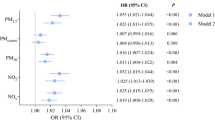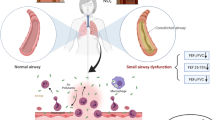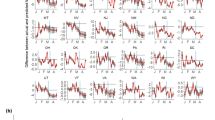Abstract
Health effects of ambient air pollution are most frequently expressed in individual studies as responses to a standardized unit of air pollution changes (e.g., an interquartile interval), which is thought to enable comparison of findings across studies. However, this approach does not necessarily convey health effects in terms of a real-world air pollution scenario. In the present study, we use population intervention modeling to estimate the effect of an air pollution intervention that makes explicit reference to the observed exposure data and is identifiable in those data. We calculate the association between ambient summertime nitrogen dioxide (NO2) and forced expiratory flow between 25% and 75% of forced vital capacity (FEF25–75) in a cohort of children with asthma in Fresno, California. We scale the effect size to reflect NO2 abatement on a majority of summer days. The effect estimates were small, imprecise, and consistently indicated improved pulmonary function with decreased NO2. The effects ranged from −0.8% of mean FEF25–75 (95% confidence interval (CI): −3.4, 1.7) to −3.3% (95% CI: −7.5, 0.9). We conclude by discussing the nature and feasibility of the exposure change analyzed here given the observed air pollution profile, and we propose additional applications of population intervention models in environmental epidemiology.
This is a preview of subscription content, access via your institution
Access options
Subscribe to this journal
Receive 6 print issues and online access
$259.00 per year
only $43.17 per issue
Buy this article
- Purchase on SpringerLink
- Instant access to full article PDF
Prices may be subject to local taxes which are calculated during checkout

Similar content being viewed by others
References
Fann N, Bell ML, Walker K, Hubbell B . Improving the linkages between air pollution epidemiology and quantitative risk assessment. Environ Health Perspect 2011; 119 (12): 1671–1675.
Bachmann J . Will the circle be unbroken: a history of the US National Ambient Air Quality Standards. J Air Waste Manage Assoc 2007; 57 (6): 652–697.
Parker J, Rich DQ, Glinianaia SV, Leem JH, Wartenberg D, Bell ML et al. The International Collaboration on Air Pollution and Pregnancy Outcomes: initial results. Environ Health Perspect 2011; 119: 1023–1028.
Greenland S, Maclure M, Schlesselman JJ, Poole C, Morgenstern H . Standardized regression coefficients: a further critique and review of some alternatives. Epidemiology 1991; 2 (5): 387–392.
Greenland S, Schlesselman JJ, Criqui MH . The fallacy of employing standardized regression coefficients and correlations as measures of effect. Am J Epidemiol 1986; 123 (2): 203–208.
Pope CA, III . Particulate pollution and health: a review of the Utah valley experience. J Expo Anal Environ Epidemiol 1996; 6 (1): 23–34.
Friedman MS, Powell KE, Hutwagner L, Graham LM, Teague WG . Impact of changes in transportation and commuting behaviors during the 1996 Summer Olympic Games in Atlanta on air quality and childhood asthma. JAMA 2001; 285 (7): 897–905.
Hubbell BJ, Hallberg A, McCubbin DR, Post E . Health-related benefits of attaining the 8-hr ozone standard. Environ Health Perspect 2005; 113 (1): 73–82.
Hubbard AE, van der Laan MJ . Population intervention models in causal inference. Biometrika 2008; 95 (1): 35–47.
Greenland S, Drescher K . Maximum likelihood estimation of the attributable fraction from logistic models. Biometrics 1993; 49 (3): 865–872.
Robins JM, Hernan MA, Brumback B . Marginal structural models and causal inference in epidemiology. Epidemiology 2000; 11 (5): 550–560.
Galea S . An argument for a consequentialist epidemiology. Am J Epidemiol 2013; 178 (8): 1185–1191.
Westreich D . From exposures to population interventions: pregnancy and response to HIV therapy. Am J Epidemiol 2014; 179 (7): 797–806.
Weinmayr G, Romeo E, De Sario M, Weiland SK, Forastiere F . Short-term effects of PM10 and NO2 on respiratory health among children with asthma or asthma-like symptoms: a systematic review and meta-analysis. Environ Health Perspect 2010; 118 (4): 449–457.
Williams ML . Patterns of air pollution in developed countries. In: Holgate ST, Samet JM, Koren HS, Maynard RL (eds). Air Pollution and Health. Academic Press: San Diego, CA. 1999.
Jerrett M, Shankardass K, Berhane K, Gauderman WJ, Kunzli N, Avol E et al. Traffic-related air pollution and asthma onset in children: a prospective cohort study with individual exposure measurement. Environ Health Perspect 2008; 116 (10): 1433–1438.
Jalaludin BB, O'Toole BI, Leeder SR . Acute effects of urban ambient air pollution on respiratory symptoms, asthma medication use, and doctor visits for asthma in a cohort of Australian children. Environ Res 2004; 95 (1): 32–42.
Mortimer KM, Neas LM, Dockery DW, Redline S, Tager IB . The effect of air pollution on inner-city children with asthma. Eur Respir J 2002; 19 (4): 699–705.
Delfino RJ, Quintana PJ, Floro J, Gastanaga VM, Samimi BS, Kleinman MT et al. Association of FEV1 in asthmatic children with personal and microenvironmental exposure to airborne particulate matter. Environ Health Perspect 2004; 112 (8): 932–941.
Liu L, Poon R, Chen L, Frescura AM, Montuschi P, Ciabattoni G et al. Acute effects of air pollution on pulmonary function, airway inflammation, and oxidative stress in asthmatic children. Environ Health Perspect 2009; 117 (4): 668–674.
Lebecque P, Kiakulanda P, Coates AL . Spirometry in the asthmatic child: is FEF25–75 a more sensitive test than FEV1/FVC? Pediatr Pulmonol 1993; 16 (1): 19–22.
Gold WM . Pulmonary function testing. In: Mason RJ, Broaddus VC, Murray JF, Nadel JA (eds. Murray and Nadel's Textbook of Respiratory Medicine 4th edn. Elsevier Saunders: Philadelphia, PA. 2005.
Mann JK, Balmes JR, Bruckner TA, Mortimer KM, Margolis HG, Pratt B et al. Short-term effects of air pollution on wheeze in asthmatic children in Fresno, California. Environ Health Perspect 2010; 118 (10): 1497–1502.
Tager IB, Lurmann FW, Haight T, Alcorn S, Penfold B, Hammond SK . Temporal and spatial patterns of ambient endotoxin concentrations in Fresno, California. Environ Health Perspect 2010; 118 (10): 1490–1496.
Meng YY, Rull RP, Wilhelm M, Lombardi C, Balmes J, Ritz B . Outdoor air pollution and uncontrolled asthma in the San Joaquin Valley, California. J Epidemiol Community Health 2009; 64: 142–147.
Mortimer KM, Fallot A, Balmes JR, Tager IB . Evaluating the use of a portable spirometer in a study of pediatric asthma. Chest 2003; 123 (6): 1899–1907.
Hetzel MR, Clark TJ . Comparison of normal and asthmatic circadian rhythms in peak expiratory flow rate. Thorax 1980; 35 (10): 732–738.
Watson JG, Chow JC, Bowen JL, Lowenthal DH, Hering S, Ouchida P et al. Air quality measurements from the Fresno Supersite. J Air Waste Manage Assoc 2000; 50 (8): 1321–1334.
Ito K, Thurston GD, Silverman RA . Characterization of PM2.5, gaseous pollutants, and meteorological interactions in the context of time-series health effects models. J Expo Sci Environ Epidemiol 2007; 17 (Suppl 2): S45–S60.
Delfino RJ, Zeiger RS, Seltzer JM, Street DH, McLaren CE . Association of asthma symptoms with peak particulate air pollution and effect modification by anti-inflammatory medication use. Environ Health Perspect 2002; 110 (10): A607–A617.
Nicolai T, Illi S, Tenborg J, Kiess W, v Mutius E . Puberty and prognosis of asthma and bronchial hyper-reactivity. Pediatr Allergy Immunol 2001; 12 (3): 142–148.
Fleischer NL, Fernald LC, Hubbard AE . Estimating the potential impacts of intervention from observational data: methods for estimating causal attributable risk in a cross-sectional analysis of depressive symptoms in Latin America. J Epidemiol Community Health 2010; 64 (1): 16–21.
Ahern J, Hubbard A, Galea S . Estimating the effects of potential public health interventions on population disease burden: a step-by-step illustration of causal inference methods. Am J Epidemiol 2009; 169 (9): 1140–1147.
Robins J . A new approach to causal inference in mortality studies with a sustained exposure period-application to control of the healthy worker survivor effect. Math Modelling 1986; 7 (9–12): 1393–1512.
Snowden JM, Rose S, Mortimer KM . Implementation of G-computation on a simulated data set: demonstration of a causal inference technique. Am J Epidemiol 2011; 173 (7): 731–738.
Basu R, Feng WY, Ostro BD . Characterizing temperature and mortality in nine California counties. Epidemiology 2008; 19 (1): 138–145.
Martinez FD . Natural history. In: Barnes PJ, Drazen JM, Rennard S, Thomson N) (eds. Asthma and COPD: Basic Mechanisms and Clinical Management. Academic Press: London, UK. 2002.
National Heart Lung and Blood Institute and World Health Organization. Global Initiative for Asthma: Global Strategy for Asthma Management and Prevention. National Institutes of Health: Bethesda, MD, USA. 2009.
Cook CD, Hamann JF . Relation of lung volumes to height in healthy persons between the ages of 5 and 38 years. J Pediatr. 1961; 59: 710–714.
Sinisi SE, van der Laan MJ . Deletion/substitution/addition algorithm in learning with applications in genomics. Stat Appl Genet Mol Biol 2004; 3: Article18.
Petersen ML, Porter KE, Gruber S, Wang Y, van der Laan MJ . Diagnosing and responding to violations in the positivity assumption. Stat Methods Med Res 2010; 21: 31–54.
Dominici F, Peng RD, Barr CD, Bell ML . Protecting human health from air pollution: shifting from a single-pollutant to a multipollutant approach. Epidemiology 2010; 21 (2): 187–194.
Cole SR, Frangakis CE . The consistency statement in causal inference: a definition or an assumption? Epidemiology 2009; 20 (1): 3–5.
Acknowledgements
This work was supported by the California Air Resources Board (contract 99-322) and the National Heart, Lung, and Blood Institute’s Division of Lung Diseases (grant number R01 HL081521).
Author information
Authors and Affiliations
Corresponding author
Ethics declarations
Competing interests
The authors declare no conflict of interest.
Additional information
Supplementary Information accompanies the paper on the Journal of Exposure Science and Environmental Epidemiology website
Supplementary information
Rights and permissions
About this article
Cite this article
Snowden, J., Mortimer, K., Kang Dufour, MS. et al. Population intervention models to estimate ambient NO2 health effects in children with asthma. J Expo Sci Environ Epidemiol 25, 567–573 (2015). https://doi.org/10.1038/jes.2014.60
Received:
Accepted:
Published:
Issue date:
DOI: https://doi.org/10.1038/jes.2014.60
Keywords
This article is cited by
-
Pesticide exposure and asthma morbidity in children residing in urban, multi-family housing
Journal of Exposure Science & Environmental Epidemiology (2023)
-
Estimating Causal Effects of Interventions on Early-life Environmental Exposures Using Observational Data
Current Environmental Health Reports (2022)
-
Environmental Exposure Mixtures: Questions and Methods to Address Them
Current Epidemiology Reports (2018)



